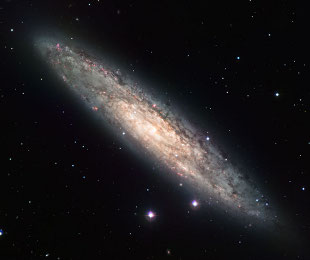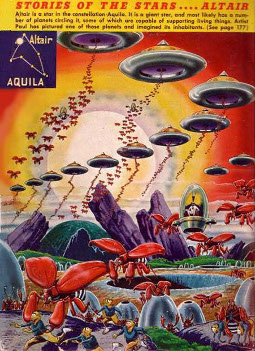The last little goodie is the equation used to determine the distance between two stars.
- DIST = SQRT[ (X1-X2)^2 + (Y1-Y2)^2 + (Z1-Z2)^2 ]
where SQRT[x] means "take the square root of x", and (x)^2 means "square x".

If Tau Ceti is at -0.99,+0.12,-3.35; and Zeta (1) Reticuli is at +1.15,-7.16,-7.84; then:
- DIST = SQRT[ (X1-X2)^2 + (Y1-Y2)^2 + (Z1-Z2)^2 ]
- DIST = SQRT[ ((-0.99)-1.15)^2 + (0.12-(-7.16))^2 + ((-3.35)-(-7.84))^2]
- DIST = SQRT[ (-2.14)^2 + (7.28)^2 + (4.49)^2 ]
- DIST = SQRT[ 4.5796 + 52.9984 + 20.1601 ]
- DIST = SQRT[ 77.7381 ]
- DIST = 8.81 parsecs
Travel Time
If you write a program to generate a list of star co-ordinates, you can then write another to input the list, then find the closest neighbor of each star. Draw lines between them to plot "trade routes" or "exploration routes". Writing a program to list out all the stars within distance X of a given star could also prove useful. Once one has decided how many times faster than light one's starship can travel, it should be easy to use the distance data to determine transit times.

Let's go from Earth to Alpha Centauri with a young lady named Bright (...who's speed is much faster than light. She set out one day. In a relative way. And returned on the previous night.).
Distance is 1.3 parsecs, which is 1.3 * 3.26 = 4.3 light years.
Bright travels 500 times light speed. So Bright will take 4.3 / 500 = 0.0086 years to travel to Alpha Centauri.
- 0.0086 years * 365 = 3.139 days (where 365 is the number of days in a year)
- 0.139 days * 24 = 3.336 hours (where 24 is the number of hours in a day)
- 0.336 hours * 60 = 20.16 minutes (where 60 is the number of minutes in an hour)
Therefore, the transit time will be 3 days, 3 hours and 20 minutes.
They seem to work, I fed in the co-ordinates of the galactic center and got a point about 10 kiloparsecs on the positive X axis. (RA 17h42m4s, DEC -28°55', DIST 27,000 light years, in case you were wondering.)
Percolation Radius

NGC 253. Photo from the European Southern Observatory.
Richard Powell has calculated the "percolation radius" for the closest stars to the Sun. The mean distance between stars within 15 light years of the sun is 3.6 light years.


